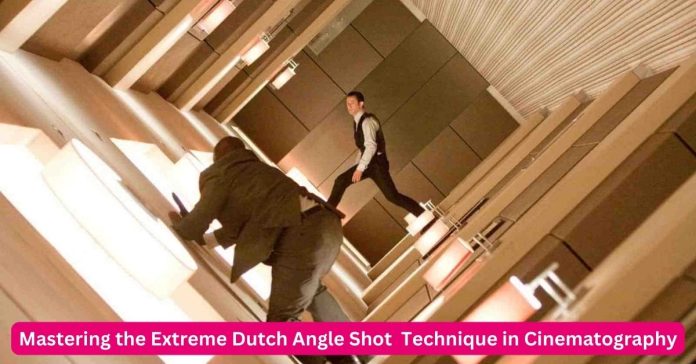In the realm of cinematography, the Dutch angle shot stands as a powerful visual tool, capable of evoking intense emotions and enhancing narrative impact. This distinctive technique involves tilting the camera off its horizontal axis, creating a sense of unease, tension, or disorientation within the frame. Also known as the Dutch tilt, canted angle, or oblique angle, this method offers filmmakers a unique means of conveying psychological states, altering perspectives, and heightening dramatic effect. In this comprehensive exploration, we delve deep into the origins, applications, and artistic implications of the Dutch angle shot, uncovering its significance in cinematic storytelling.
Dutch Angle Shot Technique in Cinematography:
Origins and Evolution:
The roots of the Dutch angle shot trace back to German Expressionism, a cinematic movement that emerged in the early 20th century. Filmmakers like Fritz Lang and Robert Wiene employed tilted angles to visually represent the distorted psychological states of their characters. One of the earliest notable examples can be found in the iconic silent film “The Cabinet of Dr. Caligari” (1920), where the skewed camera angles mirror the protagonist’s descent into madness.
Throughout the decades, the Dutch angle shot has continued to captivate filmmakers across genres and styles. From the film noir classics of the 1940s to the avant-garde experiments of the French New Wave, directors have utilized this technique to add depth, tension, and visual interest to their narratives. In more recent years, contemporary filmmakers have adapted the Dutch angle shot to suit modern storytelling, incorporating it into genres ranging from action blockbusters to psychological thrillers.
Technical Considerations:
Executing a Dutch angle shot requires careful consideration of composition, camera movement, and narrative context. While the technique can be employed in various ways to achieve different effects, certain principles remain constant:
- Composition: The key to a successful Dutch angle shot lies in achieving balance within the frame. Cinematographers must carefully frame their subjects to ensure that the tilted angle enhances the visual storytelling without becoming distracting or disorienting. By aligning elements within the frame along the skewed horizon, filmmakers can create dynamic compositions that draw the viewer’s eye and convey a sense of tension or imbalance.
- Camera Movement: The dynamic movement of the camera can amplify the impact of a Dutch angle shot, heightening the sense of disorientation or unease within the frame. Techniques such as tilting, panning, or tracking can be used to create fluid, immersive visuals that enhance the emotional resonance of the scene. However, it’s essential to maintain control over the camera movement to prevent the shot from feeling chaotic or excessive.
- Narrative Context: The decision to employ a Dutch angle shot should always serve the storytelling objectives of the film. Whether used to convey a character’s psychological state, underscore a moment of tension, or signify a shift in perspective, the tilt of the camera should be purposeful and meaningful within the context of the narrative. By aligning the visual technique with the thematic elements of the story, filmmakers can maximize its impact on the audience.
Artistic Implications:
Beyond its technical considerations, the Dutch angle shot carries profound artistic implications for filmmakers seeking to convey meaning and emotion through visual language. By tilting the camera off its axis, directors can imbue their scenes with a sense of instability, uncertainty, or impending danger. The skewed perspective invites viewers to question their perceptions, challenging them to engage more deeply with the narrative and its underlying themes.
Moreover, the Dutch angle shot offers filmmakers a powerful means of expressing subjectivity and perspective within the frame. By tilting the camera to align with a character’s point of view, directors can immerse audiences in the subjective experience of the protagonist, fostering empathy and emotional connection. Conversely, tilting the camera in opposition to the characters’ perspectives can create dramatic irony or thematic tension, inviting viewers to consider the broader implications of the narrative.
Case Studies in Dutch Angle Shot:
To illustrate the versatility and impact of the Dutch angle shot, let us examine a few notable examples from cinematic history:
- “The Third Man” (1949) – Directed by Carol Reed, this classic film noir employs Dutch angle shots to convey the moral ambiguity and existential angst of post-war Vienna. The tilted angles underscore the protagonist’s sense of disorientation and moral uncertainty as he navigates the shadowy world of espionage and intrigue.
- “Batman Begins” (2005) – Directed by Christopher Nolan, this superhero origin story utilizes Dutch angle shots to heighten the intensity and chaos of the action sequences. By tilting the camera during pivotal moments of conflict, Nolan creates a visceral sense of urgency and danger, immersing viewers in the heart-pounding excitement of Batman’s crusade against crime.
- “Inception” (2010) – Also directed by Christopher Nolan, this mind-bending sci-fi thriller employs Dutch angle shots to blur the line between reality and illusion. The tilted angles reflect the destabilizing effects of the dream world on the characters’ perceptions, creating a sense of disorientation and unreality that mirrors the thematic concerns of the film.
Conclusion:
In conclusion, the Dutch angle shot stands as a testament to the expressive power of cinematography, offering Filmmakers a versatile tool for conveying emotion, perspective, and narrative depth. Whether used to evoke psychological tension, heighten dramatic effect, or immerse viewers in the subjective experience of the characters, this distinctive technique continues to captivate audiences and inspire filmmakers across generations. By mastering the technical considerations and artistic implications of the Dutch angle shot, directors can elevate their storytelling craft and engage audiences on a deeper, more visceral level.
Must Read:
- Unveiling the Artistry of Long Shot in Cinematography: Crafting Timeless Moments on Film
- Cinematic Majesty of Birds Eye Shot: Examples from Iconic Films
- Unveiling the Artistry of Extreme Close-Up Shots in Cinematography | A Comprehensive Guide
- Mastering Cinematography Techniques: A Comprehensive Guide to Visual Storytelling




